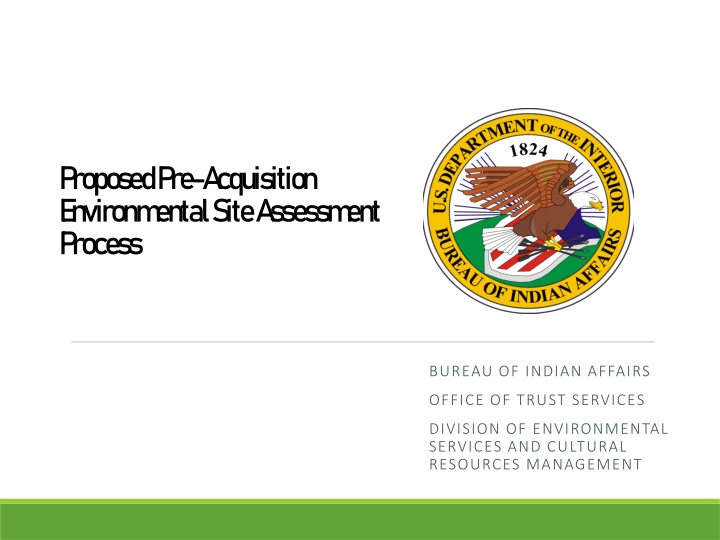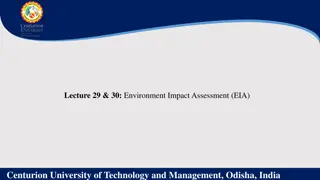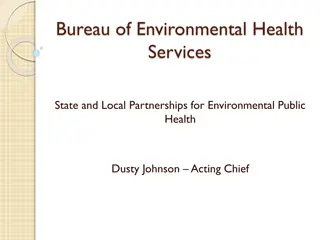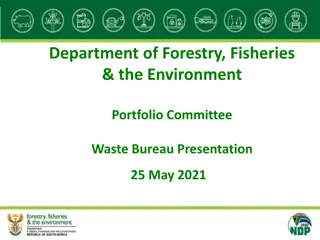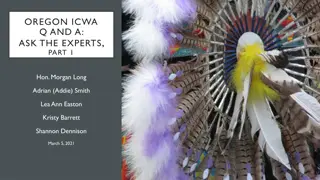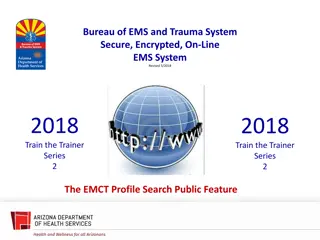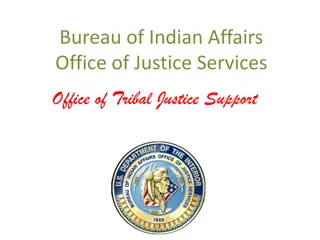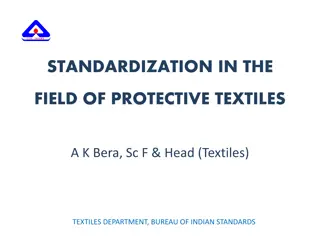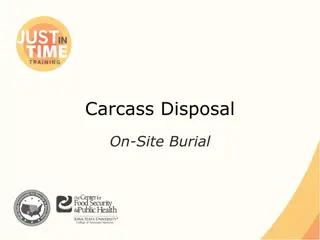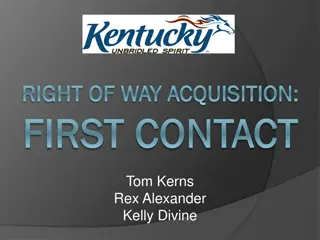Pre-Acquisition Environmental Site Assessment Process by Bureau of Indian Affairs
This document outlines the proposed Pre-Acquisition Environmental Site Assessment process by the Bureau of Indian Affairs (BIA) for fee-to-trust and real property acquisitions. It discusses the purpose of today's consultation, the scope of the assessment process, and the relevancy of Departmental Manual 602 Chapter 2 to trust acquisitions. Additionally, it introduces the proposed Indian Affairs procedures for evaluating environmental risks prior to acquiring interests in real property.
Download Presentation

Please find below an Image/Link to download the presentation.
The content on the website is provided AS IS for your information and personal use only. It may not be sold, licensed, or shared on other websites without obtaining consent from the author.If you encounter any issues during the download, it is possible that the publisher has removed the file from their server.
You are allowed to download the files provided on this website for personal or commercial use, subject to the condition that they are used lawfully. All files are the property of their respective owners.
The content on the website is provided AS IS for your information and personal use only. It may not be sold, licensed, or shared on other websites without obtaining consent from the author.
E N D
Presentation Transcript
P roposed P re-A cquisition E nvironm ental Site A ssessm ent P rocess BUREAU OF INDIAN AFFAIRS OFFICE OF TRUST SERVICES DIVISION OF ENVIRONMENTAL SERVICES AND CULTURAL RESOURCES MANAGEMENT
Purpose of Todays Consultation Purpose of Today s Consultation Indian Affairs is seeking Tribal input on draft procedures outlining the Pre-Acquisition Environmental Site Assessment process used for fee-to-trust and real property acquisitions. This process is currently captured in Departmental Manual 602 Chapter 2.
602 DM 2 602 DM 2 - -Scope Scope This chapter prescribes Departmental policy, responsibilities, and requirements for offices and bureaus to evaluate environmental risk prior to acquiring an interest in real property, including the potential to expose the Department of the Interior to fiscal or legal liabilities and costs of remediation related to the release or threatened release of hazardous substances, oil, or petroleum products, and other environmental or environmentally driven impacts on the conditions of the property to be acquired by the office/bureau.
Relevancy of 602 DM 2 to Fee Relevancy of 602 DM 2 to Fee- -to to- -Trust Trust 25 CFR 151.8 What documentation is included in a trust acquisition package? (a)(5) - The applicant must submit information that allows the Secretary to comply with the National Environmental Policy Act (NEPA) and 602 DM 2, Land Acquisitions: Hazardous Substances Determinations pursuant to 151.15; and . (ii) An acquisition package is not complete until a pre- acquisition Phase I environmental site assessment, and if necessary, a Phase II environmental site assessment completed pursuant to 602 DM 2 is determined to be sufficient by the Secretary.
Proposed Indian Affairs Procedures Proposed Indian Affairs Procedures The proposed IAM: Establishes the Indian Affairs (IA) policy, responsibilities, and requirements for programs and offices under the authority of the Assistant Secretary Indian Affairs (AS-IA) to evaluate environmental risk prior to acquiring interests in real property or other administrative land transfers to Indian Affairs jurisdiction. Establishes IA policy regarding the use of Phase I Environmental Site Assessments and the Limited Environmental Due Diligence: Transaction Screen Process that Regions may use to identify the presence or potential presence of contaminants.
Proposed Changes and Benefits Proposed Changes and Benefits Procedures would be specifically designed for BIA in dedicated Indian Affairs Manual. Placing lands in trust is unique and very different that acquiring federal public lands. BIA acquires significantly more lands than any other DOI bureau. In the majority of cases, BIA acquires lands in trust that are on-reservation and/or that are already owned by a Tribe.
Proposed Changes and Benefits Proposed Changes and Benefits Decision makers would be able to rely on results of Phase 1 ESAs for up to 30 months for certain property types that pose a significantly reduced risk of contamination: IA Office may use the conclusions of a Phase I ESA that has not been updated within 180-days for decision-making purposes for 30 months when: The property is composed of native prairie, agricultural land, or undisturbed ground with no structures or commercial business operations IA Office may use the conclusions of a Phase I ESA that has not been updated within 180-days for decision-making purposes for 18 months when: The property is rural in nature and contains no structures or non- commercial operations such as home sites, residential subdivisions, residential storage buildings
Proposed Changes and Benefits Proposed Changes and Benefits Decision makers would be able to rely on results of Limited Environmental Due Diligence/Transaction Screen Process in accordance with ASTM E1528 for certain property types. The Regional Director may determine, upon recommendation of the Environmental Professional, to use a Limited Environmental Due Diligence/Transaction Screen Process (LEDD/TSP) in accordance with the most recent version of ASTM standard E1528.
Proposed Changes and Benefits Proposed Changes and Benefits Environmental Issues of Concern/ASTM E1527 Non-scope environmental issues would not be considered in BIA s contaminant review process. Non-scope environmental issues fall outside of the scope of releases of hazardous substances, oil, or petroleum products addressed by the Comprehensive Environmental Response, Compensation, and Liability Act (CERCLA) or the Oil Pollution Act (OPA).
Proposed Changes and Benefits Proposed Changes and Benefits Contaminant review process for mandatory fee-to-trust would be documented in the IAM. Under mandatory acquisition statutes, the Secretary has no discretion to refuse to acquire land regardless of the findings of any environmental analysis. To understand whether any environmental hazards might be present, the IA Office must conduct a site investigation.
Proposed Changes and Benefits Proposed Changes and Benefits BIA would be able to develop an Environmental Professional certification program for the organization. IA may develop its own certification program for Environmental Professionals. At a minimum, the IA Office must determine what constitutes relevant experience in accordance with 40 C.F.R. 312.10(b) and 33 C.F.R. 137.25 and determine whether their personnel are Environmental Professionals. This may include using an IA training program to facilitate meeting these requirements or relevant courses provided by other agencies or bureaus/offices.
Framing Questions Framing Questions As a starting point for discussions, BIA poses the following questions: Do you have any concerns with the proposed process? Are there applicable situations that are not covered by the proposed process?
Questions? Questions? Please provide written comments to consultation@bia.gov by 11:59 on December 12, 2024
